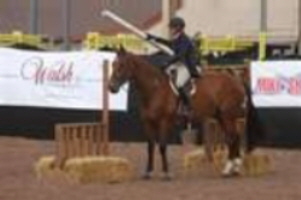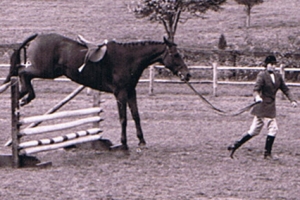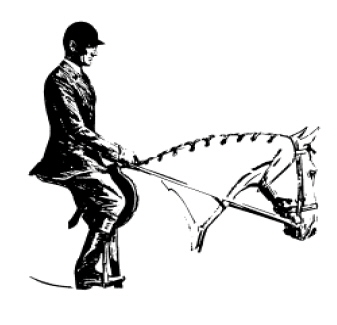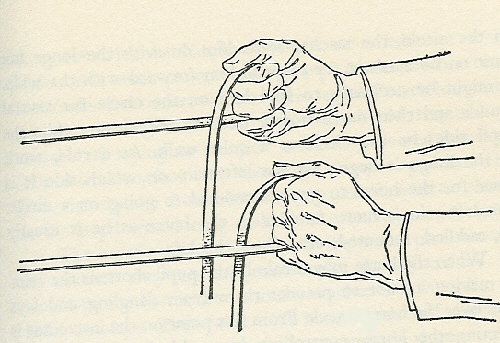IMEHA (International Model Equine Hobbyists Association) was an online photo showing site that existing until 2018. Included on the site were these guidebooks for judging and showing model horses in Performance classes. MEPSA has obtained permission to share the info contained in the guides.
Scoring :: Point Deducts :: Tack :: Rider :: Set-Up Options :: Photo Examples
Handy Hunter is an arena hunter class that combines elements of flat and over-fences classes, often with elements reminiscent of field hunting. Then in addition to jumping a course, the rider may be asked to open and close a gate or to dismount and lead the horse over a small fence. A handy hunter is not only judged on movement, but also on temperament and manners. The handy hunter should always be relaxed and calm, yet attentive to its rider. It should be responsive to invisible signals and look relatively easy to ride.
Handy hunters are well groomed for show, clean with a shiny coat. They carry a bit more weight than an eventing horse or racehorse. The hooves are normally polished before the horse enters the show ring. The horse’s head is trimmed, focusing on the whiskers around the muzzle, the hair of the ears, the bridle path, and lower jaw. The legs are also trimmed, removing all fetlock hair and feathering, and trimming the pasterns and coronet. The mane and forelock may be braided, usually using yarn matching the color of the mane. The tail may be braided from the top down to the end of the tail bone, with the rest of the tail left loose.
A good show hunter must possess an excellent jumping form. The forearm should be parallel or higher with the ground, and the knees and lower legs should be even. The horse should not be lazy with its lower legs, but should tuck them under its forearm as it clears the fence, clearly bending its fetlocks and knees. The horse should not throw its body or legs to one side, but should stay perfectly straight over the fence. A good show hunter should show a great bascule, or roundness over a jump. This is often described as the horse taking the shape of a dolphin jumping out of the water, with the horse’s back up, and its head reaching forward and down over the fence.
The handy hunter is an efficient mount. The stride is and covers much ground with little effort. It’s profile in movement is low and there is little flexion of the horse’s joints as it moves. The best hunters moves most from the shoulder and hip. The hunter moves smoothly and freely, pointing its toes as it floats over the ground. It should a kind of floating knee action with long fluid strides. The horse should be forward cadence, so it could jump if needed, but no faster than necessary. The hunter must always be in a balanced frame. The frame of the show hunter differs from that of dressage horses, eventers, and show jumpers, as it travels in a long and low frame, with its head moderately extended. Its frame is more “stretched out” than horses competing in dressage, eventing, or show jumping, but the horse should not be on its forehand. The riders of hunters often ride on a slightly looser rein than seen elsewhere to facilitate this type of movement, and the horse carries its head just in front of the vertical. Even though hunter travels in a long and low frame, it should still be able to collect its stride when necessary yet still maintain tempo and rhythm.
The walk of the show hunter is free and ground-covering; the trot should be balanced and flowing. The canter should be moderately collected. The horse should have a long galloping stride but it should still be balanced and rhythmic.
Circling once upon entering the arena before first jump is permissible.
No cross entering from Hunter Under Saddle, Hunter Pace or Hunter Hack Classes.
Obstacles Used for Handy Hunters but not limited to:
Are painted in neutral or natural colors and enhanced by plants or flowers.
Brush fences, brown or green pole with matching wing standards
Stone walls
Post and Rail
Brush
Coop
Wall
All should have a ground line on the approach side of the fence (a pole, flower box, or wall that meets the ground).
Handy Hunter fences may be flagged for course reference of approach but are not numbered.
Fences should scale to not less than 2’6″ and than more than 4’3″.
Gate to open
Designated Site For Dismount
The course must have at least two changes of direction and at least one combination as well as three of the following: walk over one obstacle, trot over one obstacle, hand gallop a jump, a bending line, a rollback turn, open a gate while mounted, halt and/or back. Judges must place emphasis on promptness and tight turns with precedence being given in that order.
Additional elements may include: putting on a rain coat, picking up an article from a barrel and taking it to someone, jump into an in & out and halt before jumping out, halting on course while another horse canters past you, dismount and lead horse over a small fence and remount.
You Score Handy Hunter on the following basis:
To be judged on manners, way of going and style of jumping. Horses shall be credited with maintaining an even hunting pace that covers the course with free-flowing strides. Preference will be given to horses with correct jumping style that meet fences squarely, jumping at the center of fence. Judges shall penalize unsafe jumping and bad form over fence, whether touched or untouched, including twisting. Incorrect leads around the ends of the course or cross-cantering shall be penalized, as well as excessive use of crop. In and outs (one or two strides) shall be taken in the correct number of strides or be penalized. Any error which endangers the horse and/or its rider, particularly refusals or knockdowns, shall be heavily penalized.
(2) Scoring shall be on a basis of 0-100, with an approximate breakdown as follows:
(A) 90-100: an excellent performer and good mover that jumps the entire course with cadence, balance and style. Performs the required additional handy hunter maneuver or obstacle willingly
(B) 80-89: a good performer that jumps all fences, maneuvers or obstacles reasonably well; an excellent performer that commits one or two minor faults.
(C) 70-79: the average, fair mover that makes no serious faults, but lacks the style, cadence and good balance of the scopier horses; the good performer that makes a few minor faults.
(D) 60-69: poor movers that make minor mistakes; fair or average movers that have one or two poor fences, maneuvers or obstacles but no major faults or disobediences.
(E) 50-59: a horse that commits one major fault, such as a hind knockdown, refusal, trot, cross canter or drops a leg.
(F) 30-49: a horse that commits two or more major faults, including front knockdowns and refusals, or jumps, maneuvers or obstacles in a manner that otherwise endangers the horse and/or rider.
(G) 10-29: a horse that avoids elimination but jumps in such an unsafe and dangerous manner as to preclude a higher score.
(e) Elimination:
(1) A total of three disobediences that can include any of the following: refusal, stop, run out or extra circle.
(2) Jumping an obstacle before it is reset.
(3) Bolting from the arena.
(4) Off course.
(5) Deliberately addressing an obstacle.
(6) Failure to trot the horse in a small circle on a loose rein for soundness, after jumping the last fence, while still mounted and prior to leaving the arena.
If You Use A Doll Rider:
Rider should have a workmanship appearance, seat and hands, light and supple. Hand should be over and in front of horse’s withers, knuckles 30 degrees inside the vertical, hand slightly apart and making a straight line from the horse’s mouth to rider’s elbow. Method of holding reins is optional. All reins are to be picked up at the same time. Eyes should be up with shoulders back, toes slightly out and ankles flexed in. Heels should be down and calf or leg in contact with horse and slightly behind girth.
The rider should sit in a comfortable, balanced, and relaxed manner while maintaining an erect upper body with eyes up and looking forward.
The rider’s legs should have a slight bend and hang beneath the rider such that when viewed from a profile, a straight line (approximately) can be drawn through the rider’s ear, shoulder, hip and heel.
The irons should be placed under the balls of the feet and not under the toe or against the heel.
Toes should be turned only slightly out with ankles flexed in toward the horse.
The lower leg should be held such that light contact would be maintained with the horse.
Arms and hands should be held in a comfortable, relaxed manner with upper arms held in a straight line with the body. The elbow is bent such that the lower arm and hands are in a straight line to the bit.
Hands should be slightly over and in front of the withers with knuckles 30 degrees inside the vertical.
Position in Motion;
At the walk and slow trot, body should be vertical with slight motion in the saddle.
At a posting trot, the body should be inclined forward with slight elevation in the saddle.
At the canter, the body should be halfway between the posting trot and the walk.
At the gallop, and while jumping, the body should be at a similar inclination as when at a posting trot.
Extra Credit Should Be Given If:
(1) Rein contact is steady but gentle at all times. It is referred to as ‘direct contact’ On a model entry this can be achieved by using sticky wax and makes the rein go in a direct straight line from the bit to the rider’s hand with no slack in the rein.
(2) Bight (Excess rein) of rein is draped on the right.
(3) Mane and tail braided with complementary color also should receive extra credit.
(4) an Entry Number is shown on saddle blanket or on rider’s back.
Points Should Be Deducted If:
(1) Model’s head is carried too high.
(2) Model displays excessive nosing out.
(9) Model displays an open mouth excessively.
(10) Rider uses spurs forward of the heart girth.
(11) Model appears sullen, dull, lethargic, emaciated, drawn or overly tired.
(12) Reins are draped and not a direct contact.
Required Tack:
Forward seat (jumping saddle)either:
Close Contact
Eventing
All-purpose
Saddles are usually of brown leather, with a plain girth, usually of leather.
The saddle pad should be white, and shaped to fit the saddle. Ideally, no more than one inch of pad should appear under the saddle.
Bridle with a plain cavesson (any type of noseband other than a plain cavesson is prohibited) and a simple, unadorned browband.
Snaffle bit, either a dee-ring, eggbutt, or full cheek design.
Milder bits are preferred in hunter classes.
Pelham bits which include a curb chain and require two sets of reins are also legal
Prohibited:
Running Martingales are forbidden.
Bit converters are illegal.
Rider:
Attire should be black, brown, brown tweed, dark green or navy hunt coat, light colored shirt with choker stock pins optional; monograms fashionable) light colored beeches with full boots or beige or canary jodhpurs with jodhpur boots. Black hard hat, any long hair should be tied up in a bun or hairnet. All participants wear black hard hats (tweed caps are permissible only if entry is historic), junior riders have the ribbons at the back of the hard hat. Attire may also be of a school uniform such as French Officer Training School uniform, Spanish Riding School, Oxford Academy, or Canadian Mountie. These uniform consists of uniform coat, beeches, full riding boots, and the style of cap or hat worn by that school.
No red hunt coats
It is suggested when using doll riders wearing these type of uniforms that the photo have a comment line used.
It is further suggested that OF Breyer red coats be stripped of color dye with Ritz bleach and then dyed black or dark brown in order for you to be able to use your rider doll in the most number of classes.
Set-Up Options:
Footing Required:
- Dirt
- Sand
- No rock base
Backboard or Natural Setting (Indoor or Outdoor Arena)
Handy Hunter Obstacle Required in photo
Arena Fencing Required:
Types of Fencing Allowed
Painted or Natural
Post and Rail
Post and Plank
Chain Link
Solid Plyboard
Plyboard with Top Rail
Post with Drape Rope
Stock Tube Pipe Rail
Interior Arena Wall
Examples of Real Handy Hunter Entries:
Doll Rider Correct Seat and Hold the Reins Correctly:

The reins are held between the ring fingers and pinkies with the thumbs solidly on top as they exit the hands. The grip is firm. Close the fingers for optimum communication and safety. Hold the hands just above the horse’s withers, in front of the saddle. Tip the thumbs toward each other at a 45-degree angle. Bend the elbows just enough to create a straight line through the forearms, hands, and reins to the horse’s mouth.
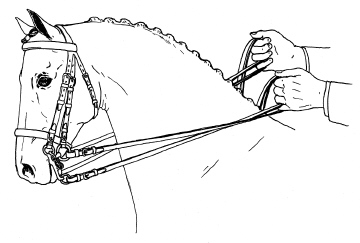
Double Bridle Reins – 2 and 2 Method. Most common handle hold in model horse hobby. It is advised that you put in your comment line what hold your set up is so that judge’s know you understand the three styles on holding the reins.

Double Bridle Reins – 3 in 1 Method. A true challenge for model horse hobbyists and doll rider’s with razor cut slips in the fingers of the hands. Left side curb goes directly back to hand and enters under ring finger with the left snaffle rein coming directly back and entering under the pinky finger with rein crossing over the curb rein. Right side curb rein goes directly back and enters under the middle finger of the left hand with all three reins coming up thru hand and out over the of the index finger with bight cascading down the right side. The right side snaffle goes directly and enters the hand under the ring finger, up into the hand and out over the top of the index finger with the bight draping down the right side. The look gives an ‘X’ to reins the left side of horse’s neck but a two independent rein look to the right side but only one rein going into the right hand. Very tricky set up.
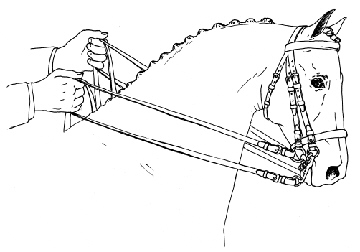
Double Bridle Reins – Fillis Method. The Fillis method of holding the reins is when the curb reins enter the rider’s hand from the bottom, around the little fingers and up to the second joint of the index fingers while the snaffle enters the fist from above over the index fingers. Each hand holds two reins.

